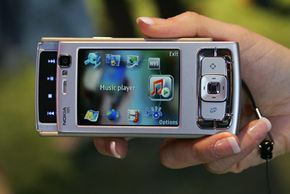It was once thought that people wouldn't be interested in video conferencing cell phones because they couldn't use them on the move (in other words, they'd be walking down the sidewalk bumping into people or lampposts while they tried to use the feature). But the popularity of texting, which is equally as hazardous, eliminated this doubt, and major cell phone companies now are equipping cell phones with the feature and beefing up networks.
The major challenge to transmitting digital video is that it requires sending a great deal of data -- much more data than audio requires. So, a cell phone with video conferencing needs to be able to send and receive a large amount of information. If you've read How Cell Phones Work, you know that, although modern cell phones are digital mechanisms, they send information over radio signals and only have a limited amount of bandwidth with which to work. Bandwidth, which is really a range of frequencies, can be expressed in units -- such as, thousands of bits per second (kbps) or millions of bits per second (Mbps). Bandwidth is an indication of how much (and how fast) data can be sent over a given communication link.
Even with more powerful 3G networks, it would be impractical and time-consuming to send every bit of digital video information over a cell phone link. So, instead, the cell phones employ video compression. This process involves reducing the digital information that needs to be sent -- in essence, whittling the digital file down to a manageable size. Compression can involve finding repetitive information and using shortcut code. The receiving cell phone would then simply need to decode the shortcuts and expand the file again.
Video compression can also mean discarding information. We can easily part with much of this information because it's simply imperceptible to the human eye. Often, to make the digital file small enough, compression discards so much information that the quality of the video noticeably suffers.
Because digital video compression is essential, experts constantly work toward inventing compression methods that reduce the information without degrading video quality. Video can be compressed in two ways:
- Block-based compression: This old-fashioned method divides an entire video image into tiny "blocks," squares of information also known as pixels, and repeatedly measures how each square changes from frame to frame.
- Object-based compression: With this more advanced compression method, the system distinguishes between moving objects (which change from frame to frame) and stationary objects (which don't change). This process is more efficient because it uses less data to record a stationary object, allowing it to devote more data to the moving objects.
In an effort to standardize compression methods across companies and industries, the Moving Picture Experts Group has come up with standards, such as the MPEG-4, which employs the object-based method.
Improved video compression is an example of better spectral efficiency (getting the most out of limited bandwidth), which is what makes 3G cellular technology more advanced than its predecessors. Another important factor that has made 3G phones possible is the development of microchips that do more (including video compression) without sucking power from the phone's battery. These are known as high-performance, low-power microchips.
But it takes more than these technological advances to make video conferencing cell phones a reality. On the next page, we'll take a look at 3G network availability. Without it, you won't be talking face to face with anyone via cell phone.





